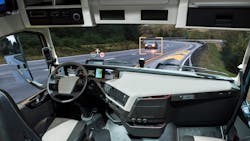As fleets continue down the path of continued advanced driver assistance system (ADAS) adoption on heavy duty trucks, it is critical that maintenance departments consider the long-term service and repair needs for these systems.
For-hire fleet Maverick Transportation has been at the forefront of testing various advanced safety technologies, working with various vehicle suppliers and manufacturers to outfit assets with ADAS technology. Greg Johnsen, regional service manager at Maverick Transportation, recently shared insights on how his fleet has approached the spec’ing and servicing of ADAS technology on its heavy duty vehicles during the S.5 study group session at the Technology & Maintenance Council Spring Meeting.
“We’re not just looking at the dollar amount, but will it help us in specific case scenarios?” Johnsen suggested. “What would the savings be long-term if we implement this technology?”
Plan outline
Maverick started testing and spec’ing various safety technologies in 2001, with the adoption of automatic tire inflation systems on its trailers. Since that time, Johnsen confirmed the company has implemented collision warning and transitioned to collision mitigation systems, forward facing camera monitoring technology, active steering, and more. Most recently, Maverick outfitted several trucks with cameras to replace mirrors and is awaiting the arrival of several units outfitted with rear outside-facing cameras.
“Maverick is going to look at anything that we can assist our drivers in being safer, or making their job easier, so we’re going to continue to look at things going forward,” Johnsen noted. He stressed, however, the importance of thinking beyond just the driver when widely adopting ADAS technology.
“We can put all the technology that we want to our units, if we don’t have a trained staff to troubleshoot, repair, or replace and understand why we’re doing that, then it is money that we’re never going to get a return on,” Johnsen said.
When Maverick decides to test a new safety technology on a truck, they will first create a test group and add that technology to a few select units. Then, Maverick gathers feedback from drivers on the usage of that technology on the truck.
“During that time, of course, the manufacturer of that product will come in,” Johnsen said. “And we will have discussions on troubleshooting guides, weak points that they may have noticed [with] other fleets that have tested this, what they have done to address those [weak points] so we know when we have a similar issue where to started looking, [et cetera].”
After gathering that information, Johnsen advised the team will set up hands-on training for technicians with these suppliers. After training is completed, Maverick creates in-house standard operating procedures (SOPs) utilizing the manufacturer’s recommendations and adjusting guidelines for the specs of units run by Maverick.
One challenge Johnsen confirmed was the instances of outside service providers servicing Maverick vehicles. To plan for this, the fleet will work to educate these service providers with the necessary information Maverick has on-hand at its own in-house service locations.
“As we get trucks in dedicated locations, we will have our internal [technicians] drop to our preferred service providers and pass that training and SOP-specific [information] for our equipment onto them to assist them with getting our trucks up and running,” Johnsen said.
Don’t forget the parts
“When you are looking to test out some technology or move forward with technology, you have to make sure that you get parts available,” Johnsen advised.
As it relates to servicing and parts availability, Johnsen said the Maverick team evaluates the top 100 parts used on the assets operated within a fleet. They then confirm with suppliers the availability and stocking levels of those parts.
“It is no different when you go to do this new technology,” Johnsen said. “Ask for some additional high-rated parts that may need replacement – definitely get parts that may need replacement due to somebody backing into your unit – and strategically place those around where your test units are going to be.”
Johnsen also offered one lesson from the service of collision warning and mitigation components, which his team learned: “Depending on the system that you have, and if you are stocking these components, be cautious as to where you put your barcode if you are using barcodes,” he advised. “A barcode on the inside of a radar cover can throw off the radar, causing more issues down the road.”
Johnsen said he has not hired additional technicians to service ADAS technologies, though he did acknowledge some technicians go through specialized training to gain a comprehensive understanding of the advanced systems.
“We have a group of people at each of our terminals who understand that technology and have training on that technology, and we try to get those units to them,” Johnsen said. And, for trucks that are down over the road, Johnsen advised, "We have a group of people in our road assist department that are trained on it as well, so they can help walk through what they are experiencing.”
About the Author
Erica Schueller
Media Relations Manager | Navistar
Erica Schueller is the Media Relations Manager for Navistar.
Before joining Navistar, Schueller served as Editorial Director of the Endeavor Commercial Vehicle Group. The commercial vehicle group includes the following brands: American Trucker, Bulk Transporter, Fleet Maintenance, FleetOwner, Refrigerated Transporter, and Trailer/Body Builders brands.
An award-winning journalist, Schueller has reported and written about the vehicle maintenance and repair industry her entire career. She has received accolades for her reporting and editing in the commercial and automotive vehicle fields by the Truck Writers of North America (TWNA), the International Automotive Media Competition (IAMC), the Folio: Eddie & Ozzie Awards and the American Society of Business Publication Editors (ASBPE) Azbee Awards.
Schueller has received recognition among her publishing industry peers as a recipient of the 2014 Folio Top Women in Media Rising Stars award, acknowledging her accomplishments of digital content management and assistance with improving the print and digital products in the Vehicle Repair Group. She was also named one Women in Trucking’s 2018 Top Women in Transportation to Watch.
She is an active member of a number of industry groups, including the American Trucking Associations' (ATA) Technology & Maintenance Council (TMC), the Auto Care Association's Young Auto Care Networking Group, GenNext, and Women in Trucking.
In December 2018, Schueller graduated at the top of her class from the Waukesha County Technical College's 10-week professional truck driving program, earning her Class A commercial driver's license (CDL).
She has worked in the vehicle repair and maintenance industry since 2008.

